2011 BMW 550I XDRIVE GRAN TURISMO open hood
[x] Cancel search: open hoodPage 13 of 297
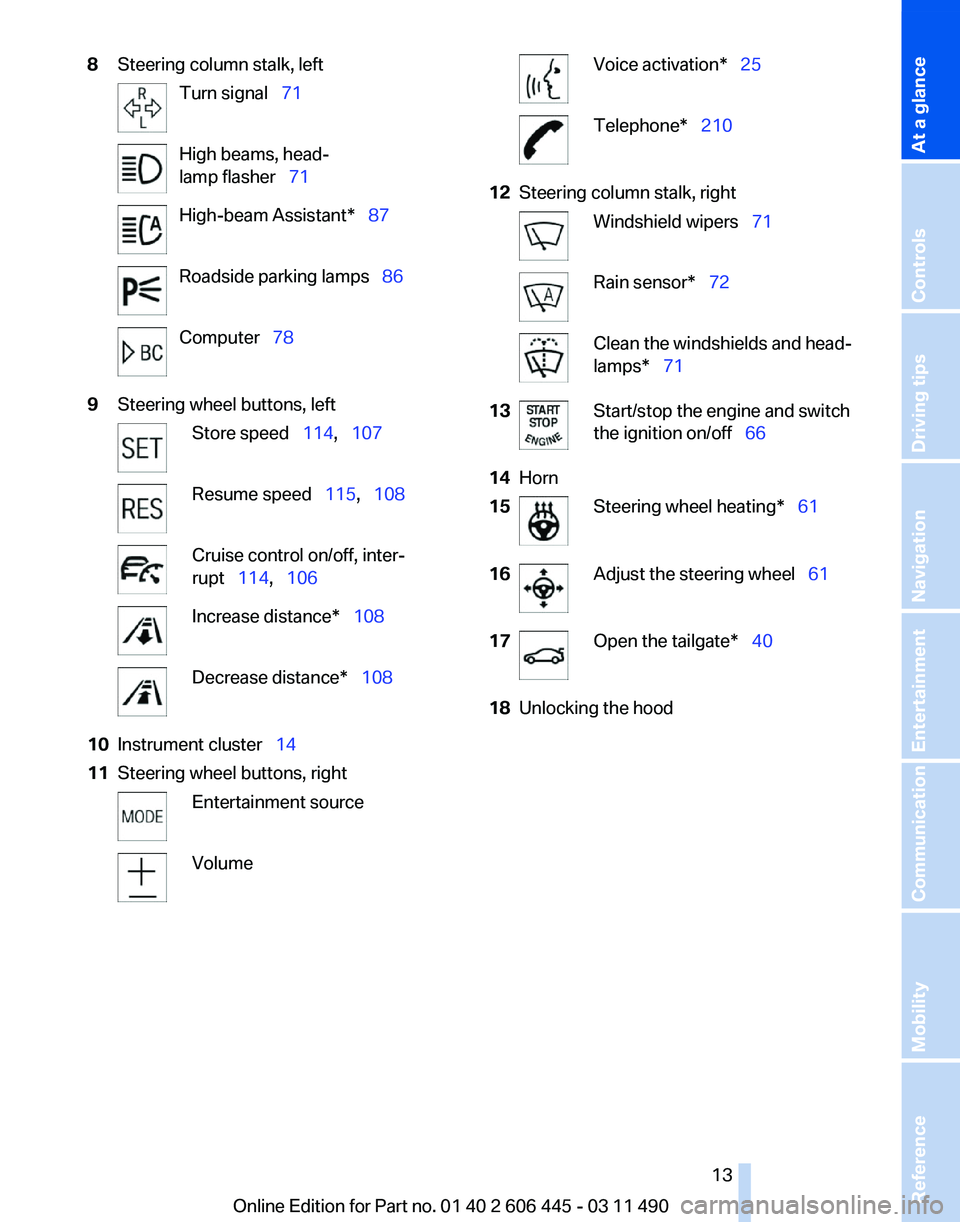
8
Steering column stalk, left Turn signal 71
High beams, head‐
lamp flasher 71
High-beam Assistant* 87
Roadside parking lamps 86
Computer 78
9 Steering wheel buttons, left Store speed 114, 107
Resume speed 115, 108
Cruise control on/off, inter‐
rupt 114, 106
Increase distance* 108
Decrease distance* 108
10 Instrument cluster 14
11 Steering wheel buttons, right Entertainment source
Volume Voice activation* 25
Telephone* 210
12 Steering column stalk, right Windshield wipers 71
Rain sensor*
72 Clean the windshields and head‐
lamps* 71
13 Start/stop the engine and switch
the ignition on/off 66
14 Horn
15 Steering wheel heating* 61
16 Adjust the steering wheel
61
17 Open the tailgate* 40
18 Unlocking the hood
Seite 13
13Online Edition for Part no. 01 40 2 606 445 - 03 11 490
Reference Mobility Communication Entertainment Navigation Driving tips Controls
At a glance
Page 44 of 297
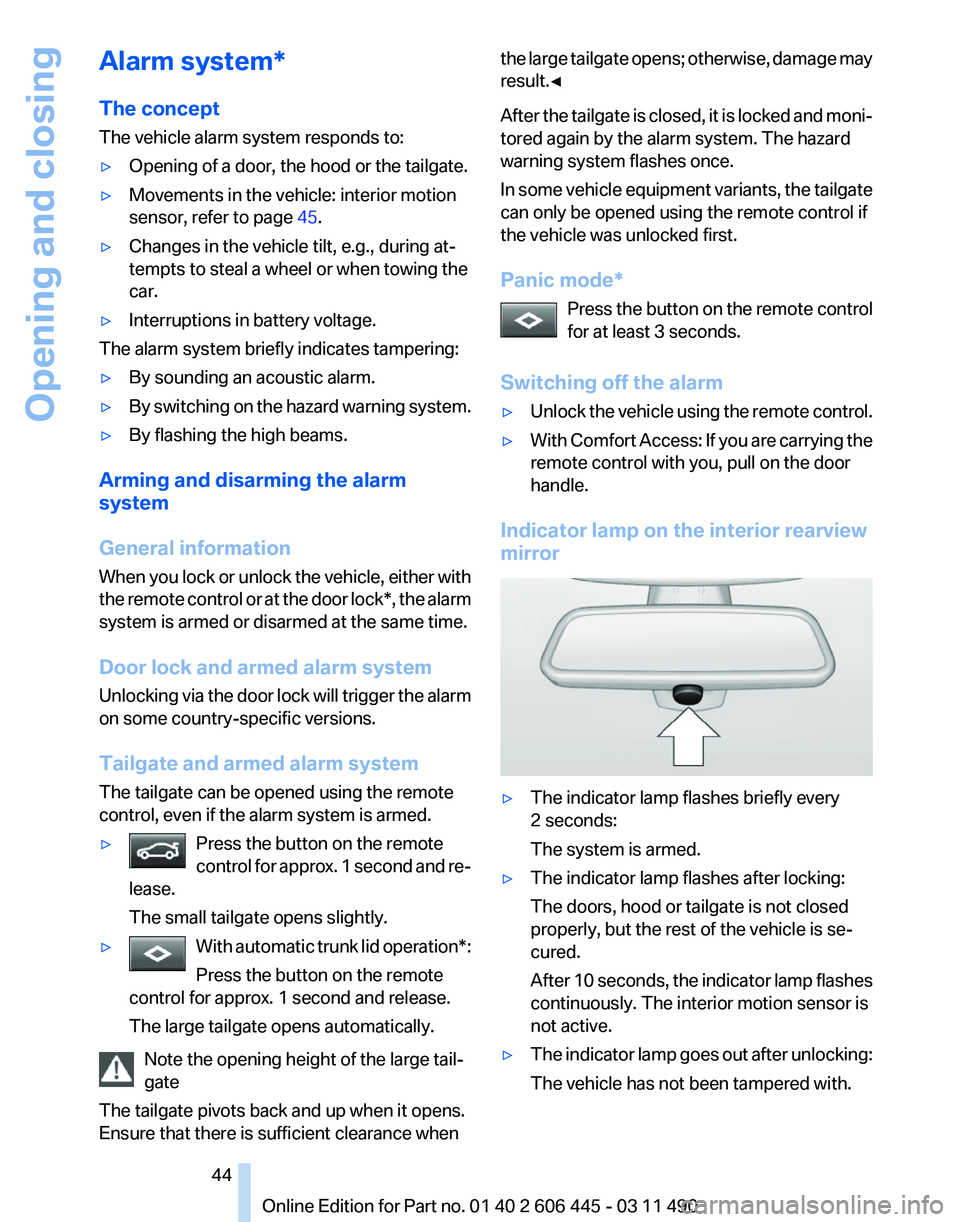
Alarm system*
The concept
The vehicle alarm system responds to:
▷
Opening of a door, the hood or the tailgate.
▷ Movements in the vehicle: interior motion
sensor, refer to page 45.
▷ Changes in the vehicle tilt, e.g., during at‐
tempts to steal a wheel or when towing the
car.
▷ Interruptions in battery voltage.
The alarm system briefly indicates tampering:
▷ By sounding an acoustic alarm.
▷ By switching on the hazard warning system.
▷ By flashing the high beams.
Arming and disarming the alarm
system
General information
When
you lock or unlock the vehicle, either with
the remote control or at the door lock*, the alarm
system is armed or disarmed at the same time.
Door lock and armed alarm system
Unlocking via the door lock will trigger the alarm
on some country-specific versions.
Tailgate and armed alarm system
The tailgate can be opened using the remote
control, even if the alarm system is armed.
▷ Press the button on the remote
control
for approx. 1 second and re‐
lease.
The small tailgate opens slightly. ▷
With automatic trunk lid operation*:
Press the button on the remote
control for approx. 1 second and release.
The large tailgate opens automatically. Note the opening height of the large tail‐
gate
The tailgate pivots back and up when it opens.
Ensure that there is sufficient clearance when the large tailgate opens; otherwise, damage may
result.◀
After
the tailgate is closed, it is locked and moni‐
tored again by the alarm system. The hazard
warning system flashes once.
In some vehicle equipment variants, the tailgate
can only be opened using the remote control if
the vehicle was unlocked first.
Panic mode*
Press the button on the remote control
for at least 3 seconds.
Switching off the alarm
▷ Unlock the vehicle using the remote control.
▷ With Comfort Access: If you are carrying the
remote control with you, pull on the door
handle.
Indicator lamp on the interior rearview
mirror ▷
The indicator lamp flashes briefly every
2 seconds:
The system is armed.
▷ The indicator lamp flashes after locking:
The doors, hood or tailgate is not closed
properly, but the rest of the vehicle is se‐
cured.
After
10 seconds, the indicator lamp flashes
continuously. The interior motion sensor is
not active.
▷ The indicator lamp goes out after unlocking:
The vehicle has not been tampered with. Seite 44
44 Online Edition for Part no. 01 40 2 606 445 - 03 11 490
Opening and closing
Page 251 of 297
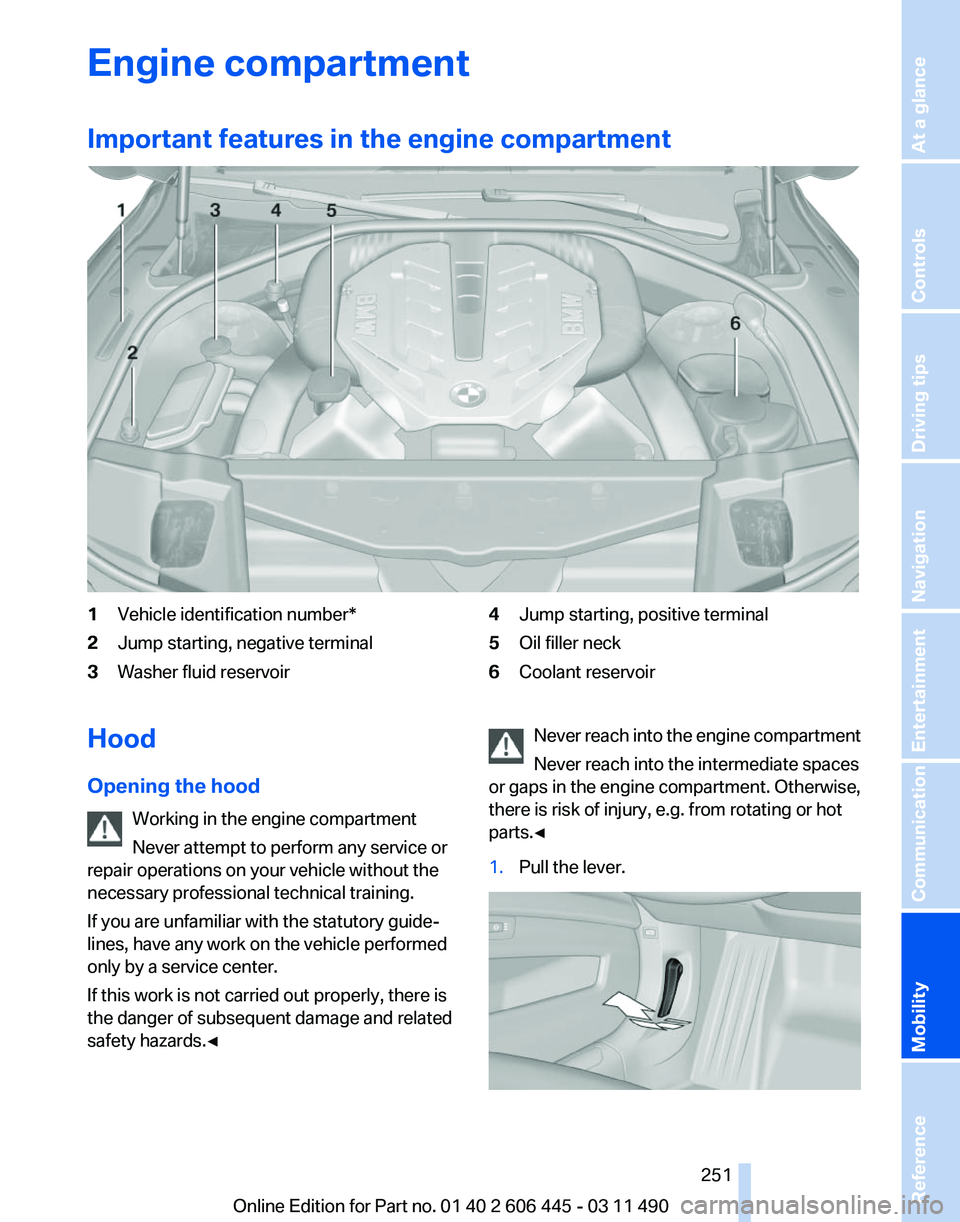
Engine compartment
Important features in the engine compartment
1
Vehicle identification number*
2 Jump starting, negative terminal
3 Washer fluid reservoir 4
Jump starting, positive terminal
5 Oil filler neck
6 Coolant reservoir
Hood
Opening the hood Working in the engine compartment
Never attempt to perform any service or
repair operations on your vehicle without the
necessary professional technical training.
If you are unfamiliar with the statutory guide‐
lines, have any work on the vehicle performed
only by a service center.
If this work is not carried out properly, there is
the danger of subsequent damage and related
safety hazards.◀ Never reach into the engine compartment
Never reach into the intermediate spaces
or gaps in the engine compartment. Otherwise,
there is risk of injury, e.g. from rotating or hot
parts.◀
1. Pull the lever. Seite 251
251Online Edition for Part no. 01 40 2 606 445 - 03 11 490
Reference
Mobility Communication Entertainment Navigation Driving tips Controls At a glance
Page 252 of 297
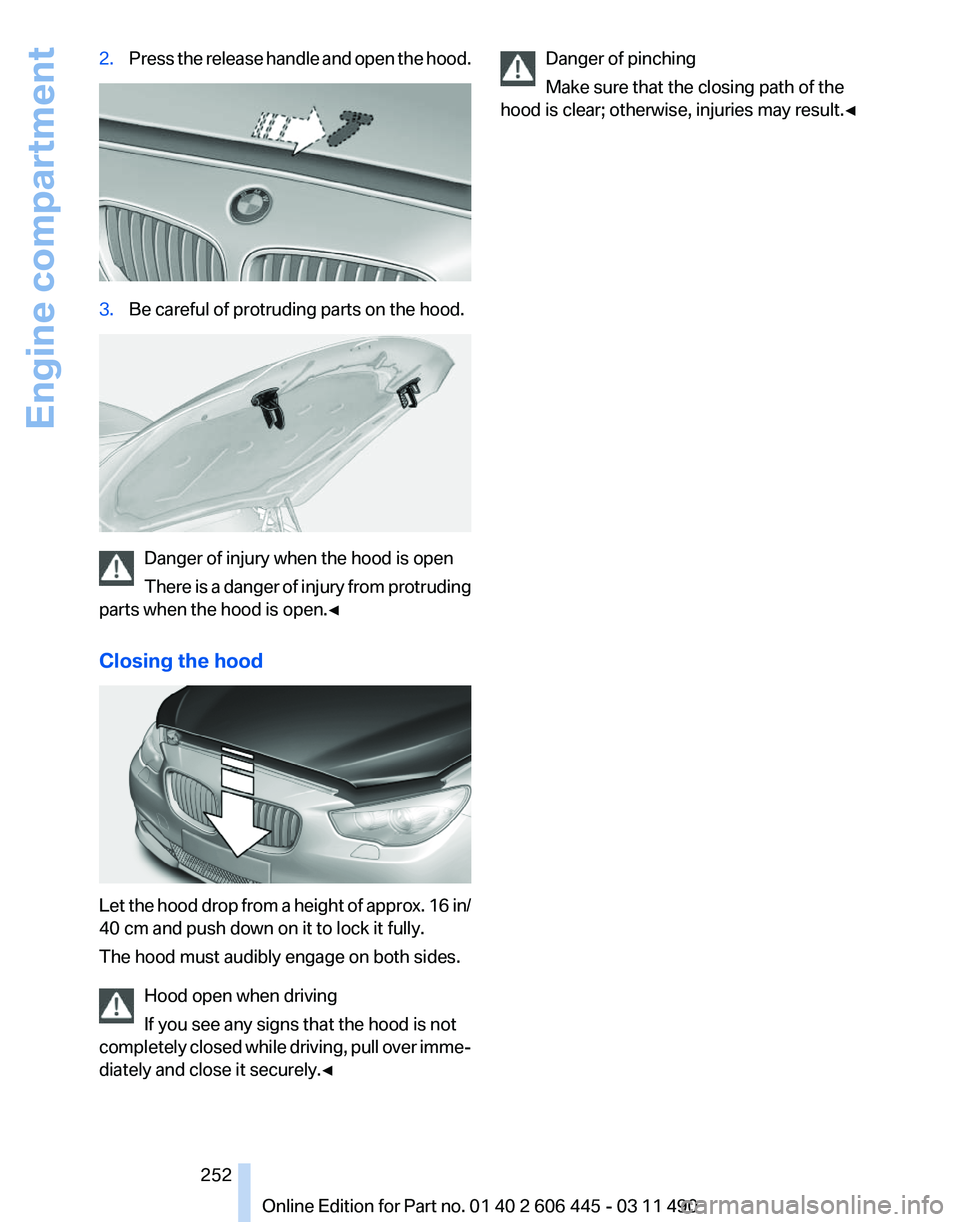
2.
Press the release handle and open the hood. 3.
Be careful of protruding parts on the hood. Danger of injury when the hood is open
There
is a danger of injury from protruding
parts when the hood is open.◀
Closing the hood Let the hood drop from a height of approx. 16 in/
40 cm and push down on it to lock it fully.
The hood must audibly engage on both sides.
Hood open when driving
If you see any signs that the hood is not
completely
closed while driving, pull over imme‐
diately and close it securely.◀ Danger of pinching
Make sure that the closing path of the
hood is clear; otherwise, injuries may result.◀ Seite 252
252 Online Edition for Part no. 01 40 2 606 445 - 03 11 490
Engine compartment
Page 289 of 297
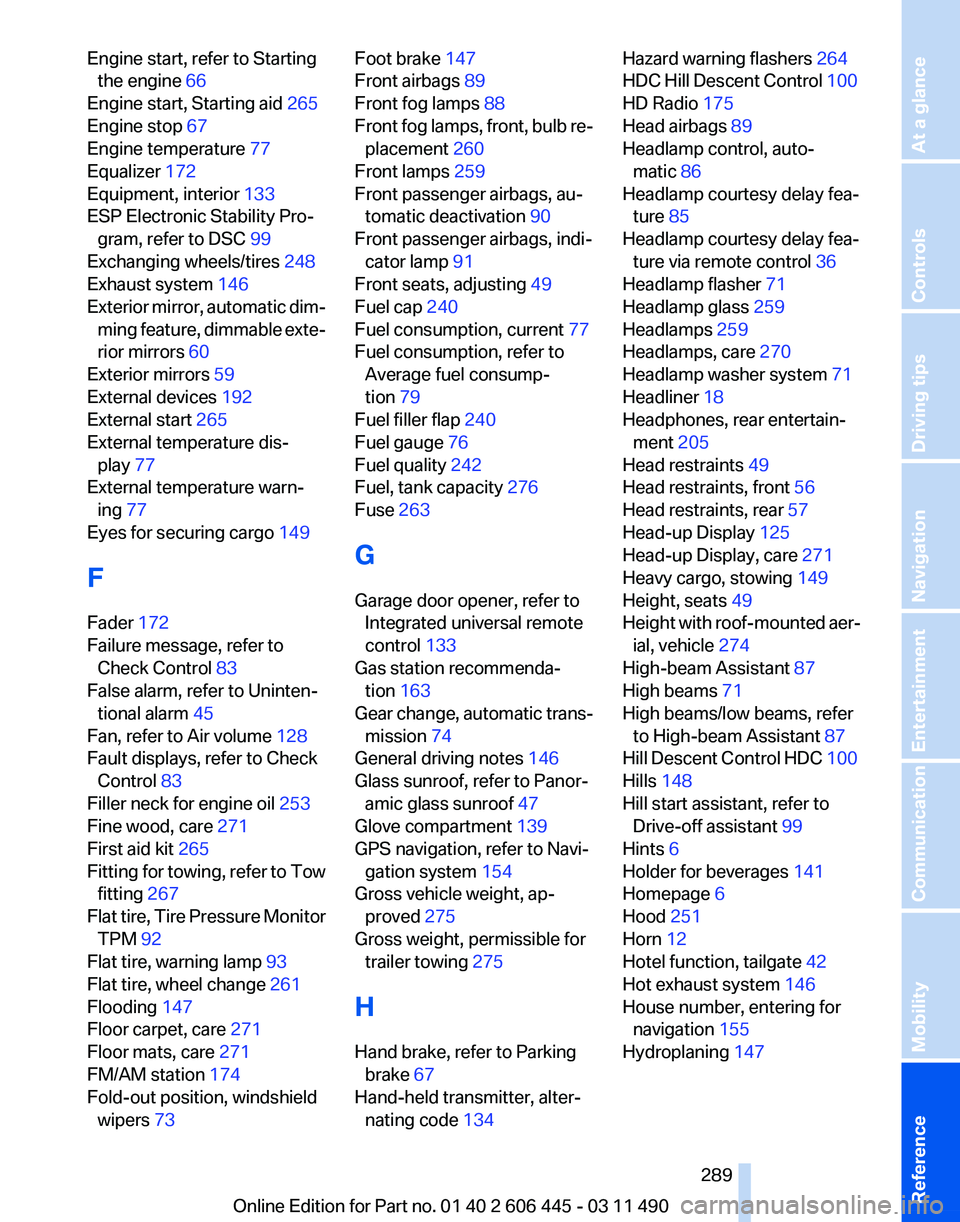
Engine start, refer to Starting
the engine 66
Engine start, Starting aid 265
Engine stop 67
Engine temperature 77
Equalizer 172
Equipment, interior 133
ESP Electronic Stability Pro‐ gram, refer to DSC 99
Exchanging wheels/tires 248
Exhaust system 146
Exterior
mirror, automatic dim‐
ming feature, dimmable exte‐
rior mirrors 60
Exterior mirrors 59
External devices 192
External start 265
External temperature dis‐ play 77
External temperature warn‐ ing 77
Eyes for securing cargo 149
F
Fader 172
Failure message, refer to Check Control 83
False alarm, refer to Uninten‐ tional alarm 45
Fan, refer to Air volume 128
Fault displays, refer to Check Control 83
Filler neck for engine oil 253
Fine wood, care 271
First aid kit 265
Fitting for towing, refer to Tow fitting 267
Flat tire, Tire Pressure Monitor TPM 92
Flat tire, warning lamp 93
Flat tire, wheel change 261
Flooding 147
Floor carpet, care 271
Floor mats, care 271
FM/AM station 174
Fold-out position, windshield wipers 73 Foot brake
147
Front airbags 89
Front fog lamps 88
Front
fog lamps, front, bulb re‐
placement 260
Front lamps 259
Front passenger airbags, au‐ tomatic deactivation 90
Front passenger airbags, indi‐ cator lamp 91
Front seats, adjusting 49
Fuel cap 240
Fuel consumption, current 77
Fuel consumption, refer to Average fuel consump‐
tion 79
Fuel filler flap 240
Fuel gauge 76
Fuel quality 242
Fuel, tank capacity 276
Fuse 263
G
Garage door opener, refer to Integrated universal remote
control 133
Gas station recommenda‐ tion 163
Gear change, automatic trans‐ mission 74
General driving notes 146
Glass sunroof, refer to Panor‐ amic glass sunroof 47
Glove compartment 139
GPS navigation, refer to Navi‐ gation system 154
Gross vehicle weight, ap‐ proved 275
Gross weight, permissible for trailer towing 275
H
Hand brake, refer to Parking brake 67
Hand-held transmitter, alter‐ nating code 134 Hazard warning flashers 264
HDC
Hill Descent Control 100
HD Radio 175
Head airbags 89
Headlamp control, auto‐ matic 86
Headlamp courtesy delay fea‐ ture 85
Headlamp courtesy delay fea‐ ture via remote control 36
Headlamp flasher 71
Headlamp glass 259
Headlamps 259
Headlamps, care 270
Headlamp washer system 71
Headliner 18
Headphones, rear entertain‐ ment 205
Head restraints 49
Head restraints, front 56
Head restraints, rear 57
Head-up Display 125
Head-up Display, care 271
Heavy cargo, stowing 149
Height, seats 49
Height with roof-mounted aer‐ ial, vehicle 274
High-beam Assistant 87
High beams 71
High beams/low beams, refer to High-beam Assistant 87
Hill Descent Control HDC 100
Hills 148
Hill start assistant, refer to Drive-off assistant 99
Hints 6
Holder for beverages 141
Homepage 6
Hood 251
Horn 12
Hotel function, tailgate 42
Hot exhaust system 146
House number, entering for navigation 155
Hydroplaning 147
Seite 289
289Online Edition for Part no. 01 40 2 606 445 - 03 11 490
Reference Mobility Communication Entertainment Navigation Driving tips Controls At a glance